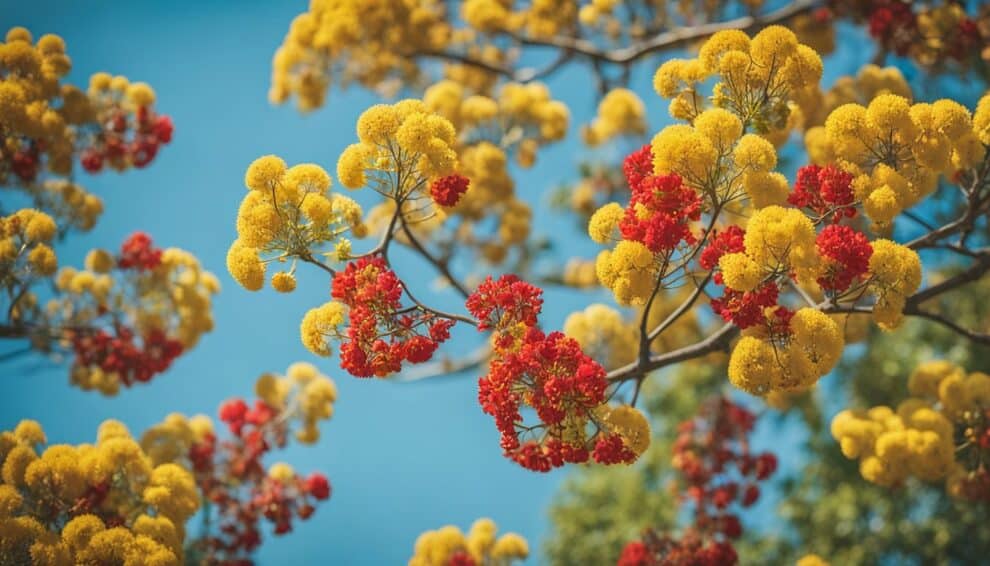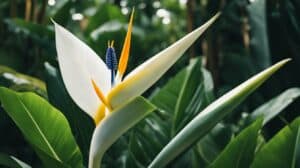Caesalpinia Pulcherrima, commonly known as the Pride of Barbados, is a stunning flowering plant that is native to the Caribbean and Mexico.
This plant is widely cultivated for its beautiful and vibrant flowers, which range in color from yellow and orange to red.
The Pride of Barbados is a member of the legume family and is known for its hardiness and ability to thrive in a variety of environments.

The Pride of Barbados is a popular ornamental plant that is commonly used in landscaping and gardening.
Its striking flowers and attractive foliage make it a favorite among gardeners and horticulturists.
In addition to its beauty, the Pride of Barbados is also valued for its medicinal properties.
The plant has been used for centuries in traditional medicine to treat a variety of ailments, including fever, inflammation, and pain.
Despite its popularity, the Pride of Barbados is not without its challenges.
The plant is susceptible to a number of pests and diseases, and its growth can be affected by a variety of environmental factors.
However, with proper care and attention, the Pride of Barbados can thrive and continue to be a source of beauty and inspiration for generations to come.
Origins and Habitat

Geographic Distribution
Caesalpinia pulcherrima, commonly known as Pride of Barbados, is a species of flowering plant that belongs to the Fabaceae family.
It is native to the tropical regions of the Americas, including the Caribbean, Mexico, and Central and South America.
The plant is widely cultivated in many parts of the world, including Asia, Africa, and Australia.
Natural Habitat
Pride of Barbados is a hardy plant that can grow in a variety of habitats, including savannas, forests, and disturbed areas.
It prefers well-drained soils and can tolerate drought conditions.
The plant is often found in coastal regions, where it can withstand salt spray and strong winds.
In its natural habitat, Pride of Barbados is an important source of food and shelter for many animals, including birds, bees, and butterflies.
The plant produces nectar-rich flowers that attract a wide range of pollinators, making it an important component of many ecosystems.
Overall, the Pride of Barbados is a fascinating plant with a rich history and a wide range of uses.
Its beautiful flowers, adaptability, and ecological importance make it a valuable addition to any garden or landscape.
Botanical Description

Plant Structure
Caesalpinia Pulcherrima, commonly known as Pride of Barbados, is a shrub or small tree that can grow up to 4-6 meters tall.
It has a slender trunk and a spreading crown with branches that are armed with spines.
The leaves are pinnately compound, with 5-12 pairs of leaflets that are ovate or oblong in shape and about 2-5 cm long.
The leaflets are dark green in color and have a glossy texture.
Flowering and Fruiting
The flowers of Caesalpinia Pulcherrima are the main attraction of the plant. They are arranged in large terminal clusters and are about 5 cm in diameter.
The flowers have five petals that are bright red, orange, or yellow in color, with long, prominent stamens that are also colored.
The flowering season of the plant is from late spring to early fall.
After flowering, Caesalpinia Pulcherrima produces long, slender seed pods that are about 15-30 cm in length. The pods are flat and contain 6-10 seeds each.
The seeds are small, brown, and hard, and are dispersed by wind or animals.
Overall, Caesalpinia Pulcherrima is a beautiful and ornamental plant that can add a splash of color to any garden.
Its unique structure and vibrant flowers make it a popular choice among gardeners and horticulturists alike.
Cultivation and Care
Growing Conditions
Caesalpinia Pulcherrima, commonly known as Pride of Barbados, is a tropical plant that thrives in warm and humid climates.
It requires full sun exposure and well-draining soil to grow healthy and produce vibrant blooms.
In areas with cold winters, it is best grown in containers that can be moved indoors during the winter months.
Maintenance and Pruning
Regular maintenance is required to keep Caesalpinia Pulcherrima healthy and blooming throughout the year.
It is important to water the plant regularly, especially during dry spells, and to fertilize it every two to three months with a balanced fertilizer.
Pruning is also necessary to maintain its shape and promote new growth. It is recommended to prune the plant in early spring before new growth appears.
Deadheading spent blooms will encourage the plant to produce more flowers.
To prevent pest and disease problems, it is important to keep the plant clean and free of debris.
Regularly inspect the plant for signs of pests or diseases, and treat them promptly if detected.
Significance and Uses

Cultural Importance
Caesalpinia Pulcherrima, also known as the Pride of Barbados, is a plant that holds significant cultural importance in many regions of the world.
In Barbados, it is the national flower and is used to decorate events and festivals.
It is also used in traditional medicine and has been incorporated into various cultural practices.
In Mexico, the plant is known as “pongamia” and is used in religious ceremonies.
The bright red and yellow flowers are believed to represent the blood and gold of the Aztec gods.
In India, it is known as “Krishna Kamal” and is associated with Lord Krishna.
The plant is often used in Hindu weddings as a symbol of love and prosperity.
Medicinal Applications
The Pride of Barbados has been used for medicinal purposes for centuries. The leaves, flowers, and seeds of the plant are all used in traditional medicine.
The leaves and flowers are used to treat a variety of ailments such as fever, cough, and skin infections.
The seeds are used to treat digestive issues such as diarrhea and dysentery.
Research has also shown that the plant contains compounds with anti-inflammatory and antioxidant properties.
These compounds have been found to be effective in treating conditions such as arthritis and cancer.
Overall, the cultural and medicinal significance of Caesalpinia Pulcherrima makes it a valuable plant in many parts of the world.
Its vibrant colors and diverse uses make it a symbol of beauty, love, and healing.
Frequently Asked Questions

What are the ideal growing conditions for Pride of Barbados?
Caesalpinia pulcherrima grows best in full sun and well-draining soil. It prefers warm temperatures and is drought-tolerant once established.
It can also tolerate salt spray, making it suitable for coastal areas.
How do you care for a Caesalpinia pulcherrima plant?
Water the plant regularly during the growing season, but do not overwater. Fertilize with a balanced fertilizer every two to three months.
Prune the plant after flowering to maintain its shape and size.
Are there any common pests or diseases that affect the Pride of Barbados?
The plant is generally pest and disease-resistant.
However, it may be susceptible to scale insects, spider mites, and fungal diseases in humid conditions.
Can Pride of Barbados be grown in cooler climates?
The plant is native to tropical and subtropical regions and does not tolerate frost. It can be grown in cooler climates as an annual or in a greenhouse.
What are the different uses of Caesalpinia pulcherrima in landscaping?
The plant is commonly used as a specimen plant, in mixed borders, or as a hedge. It also attracts butterflies and hummingbirds with its showy flowers.
How do you propagate the Pride of Barbados?
Propagation can be done through seeds or cuttings. Seeds should be scarified before planting to improve germination rates.
Cuttings should be taken in the spring or early summer and treated with rooting hormone before planting.














